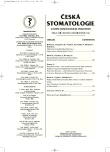Our Contribution to Semipermanent Splinting
Authors:
L. Roubalíková 1; J. Jančář 2; Z. Šedivý 2
Authors‘ workplace:
Stomatologická klinika LF MU a FN U Sv. Anny, Brno
přednosta prof. MUDr. J. Vaněk, CSc.
1; Ústav chemie materiálů VUT, Brno
ředitel prof. RNDr. J. Jančář, CSc.
2
Published in:
Česká stomatologie / Praktické zubní lékařství, ročník 106, 2006, 6, s. 105-110
Category:
Overview
Fiber composites have multiple uses in dental medicine. Possible clinical applications include the application of splints in the course of therapy of pulpoperiodontal diseases. Advanced stages of pulpoperiodontal affections require a complex approach – endodontic treatment together with the treatment of periodontium. In the described affection the tooth tends to be loose and this condition tends to deteriorate, though often transiently. That is why splints are indicated already before the beginning of the treatment. The authors describe the procedure encountered in making short splints from the fiber composite DentapregTM and present their own experience with 12 splints in the frontal segment. The splints were applied before the beginning of a complex endodonticperiodontium therapy and remained with the consent of the patient in situ until the disease becomes stable. Two of the 12 splints became loosen after 3 months elapsed, but the other remained in oral cavity. The longest time period of integration was 2 years, the shortest one lasted 3 months.
Key words:
pulpoperiodontal disease – fiber composites – splints – semipermanent spinting
Labels
Maxillofacial surgery Orthodontics Dental medicineArticle was published in
Czech Dental Journal

2006 Issue 6
Most read in this issue
- Inflammatory Myofibroblastic Tumor
- Distraction Exercise – a New Method for Conservative Treatment of Anterior Dislocation of Temporomandibular Joint Disc
- Our Contribution to Semipermanent Splinting
- Late Orthodontic Prosthetic Therapy with the Use of Delair Mask
